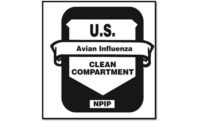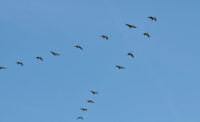As the U.S. poultry industry continues to deal with highly pathogenic avian influenza virus infection in the Midwest, it is important to reflect on why this virus has spread through a section of the industry and how the poultry industry has prepared itself for control of this disease.
The avian influenza virus that has infected commercial poultry in the U.S. is unusual in several respects. The first unusual characteristic is that it originated in Asia. It is extremely rare for an Asian avian influenza virus to cross the Pacific Ocean and establish itself in birds in North America. How this occurred is not clear, but it may have involved the migration of wild birds across the Bering Sea.
What is clear is that once the virus entered populations of North American wild birds, it re-combined with a North American low-pathogenic avian influenza virus to form a hybrid virus with a part-Asian and part-North American makeup. This hybrid virus is the one that currently is causing infections in the Midwest.
The second unusual characteristic of this virus is that, although it is highly pathogenic in chickens and turkeys, it is not pathogenic to the wild birds which carry the virus. The virus is carried and transmitted by wild populations of waterfowl and apparently causes little or no illness in these birds. The significance of this trait is that huge flocks of ducks and geese are migrating northward along the Mississippi River to reach their summer breeding grounds, and many of these birds are infected with the virus and shedding it in their feces. Because the virus does not make the waterfowl ill, they are able to fly thousands of miles, shedding the virus as they go.
Avian influenza has entered the U.S. commercial poultry industry several times in the past 30 years, and in each case the disease was contained and eradicated. Over time, much has been learned regarding how to prevent the disease, how to detect the virus and how to eradicate the virus from outbreaks.
Poultry companies have developed biosecurity programs that are designed to prevent introduction of the virus. These programs involve all people and every step of poultry production. Overall, the programs have worked well to limit introduction of avian influenza virus into commercial poultry and to contain its spread if it is introduced. Very sophisticated programs are now used to detect the virus. All flocks are monitored for avian influenza through a program directed by the National Poultry Improvement Plan (NPIP). This serves as a national “early warning system” for avian influenza and has worked very well to quickly detect any introduction of avian influenza into commercial poultry.
Each poultry-producing state now has an avian influenza response plan which complements and augments the national avian influenza response plan administered by the U.S. Department of Agriculture (USDA). It is this cooperative state and federal response that has been so successful in the eradication of this disease.
The poultry industry, state governments and the USDA are working diligently to contain and eradicate our current outbreak of avian influenza. Lessons learned from past outbreaks are proving valuable today.





Report Abusive Comment